More bad news on the climate front. Researchers based in Korea, Canada and Germany say in a paper published in the journal Nature Communications that the Arctic could be deprived of sea ice in September as early as the 2030s, 10 years earlier than the IPCC had predicted.
Experts speak of absence of ice when the surface is less than one million km² out of the 14 million km² of the Arctic Ocean. As a reminder, sea ice is frozen seawater found on the surface of an ocean, more commonly known as pack ice.
See alsoGlobal warming reaches a new record
This will happen "regardless of the emission scenarios", say the scientists who warn that it is already too late, even if CO2 emissions were to be reduced. They believe that the decline of this ice can be attributed in large part to greenhouse gas emissions.
September is mentioned by scientists because it is the period during which sea ice reaches its minimum area each year, as shown in our infographic below.
More extreme weather events coming
While its melting does not have a direct impact on sea level rise, it plays a very important role. It is a key component of Arctic and Antarctic ecosystems, vital for various polar species, particularly seals and polar bears, as it helps keep polar habitats cold. It is therefore a real threat to marine biodiversity.
The sea ice has an essential role in summer, since it allows to reflect the rays of the sun and thus to cool the Arctic. By melting, solar heat warms the Arctic and other regions faster, accelerating ice melt and sea level rise.
With the ice surface shrinking over the years (Editor's note: 13% of sea ice lost each decade, according to the IPCC), the Arctic is warming faster than other regions. Arctic sea ice is even warming twice as fast as the rest of the globe, according to the IPCC.
The disappearance of the ice "will accelerate Arctic warming, which can increase extreme weather events in mid-latitudes, such as heat waves and forest fires," Seung-Ki Min said. "It can also accelerate global warming, by melting permafrost, as well as rising sea levels by melting the Greenland ice sheet," he adds.
The lead author of the study also recalls that sea ice is "a driver of global ocean circulation", with consequences that are still difficult to assess today.













